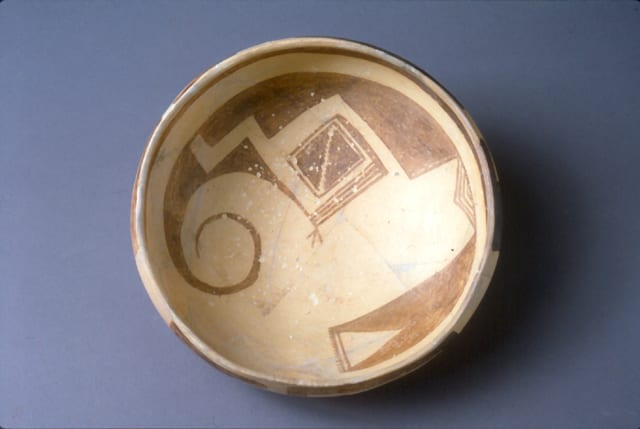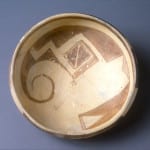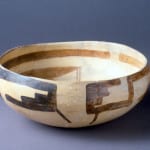Jeddito “brown on buff” bowl with interior spiral and sash designs and three repetitions of an S-stepped glyph on the exterior, circa 1450-1550 AD. (While the colors of this particular bowl are “brown on buff,” this pot is technically an example of Jeddito Black-on-Yellow ware. According to Baer, from whom I purchased the pot, “Condition is excellent with less than 2% restoration; basically just pieces glued together.”
In 2009 the Peabody Museum of Archeology and Ethnography at Harvard University published Vol. 84 of their “papers”: Symbols in Clay: Seeking Artists’ Identities in Hopi Yellow Ware Bowls, by Steven A. LeBlanc and Lucia R. Henderson. A central finding of their study of Jeddito bowls was that “the glyphlike exterior designs on (such bowls) do in fact represent ‘signatures’ either of individuals or of slightly larger ‘artist groups.’ From about 1,510 workable images of bowls, we identified some 175 groups of closely similar signatures, which we call ‘sets.’ (LeBlanc and Henderson, 2009:1)” The exterior of bowl 1994-15 seems to represent “set 60”(2009:51 and 123), a conclusion supported by Steven LeBlanc after seeing photographs of 1994-15 online (personal email, July 2009, on file).
LeBlanc and Henderson argue that the exterior glyphs were often casually applied, even when a bowl’s interior was carefully constructed. This pattern is clear on 1994-15, two exterior glyphs have major paint drips and one the start of a drip. The exterior designs were so casually applied that when the first glyph paint dripped, the artist did not bother to correct the “problem” on the subsequent two designs. In contrast, the interior of the bowl is carefully decorated.
A jeddito bowl with the same glyph as bowl 1994-15 (except reversed, as in a mirror) was excavated outside of Awatovi in the 1930’s in Test 7, Room 1 and is illustrated by Watson (2005:256 and 257, fig. 21, c).
Kelley A. Hays presents a typology of Jeddito ware and writes that “chronologically later Jeddito Black-on-yellow tends to be light yellow…, have no visible temper or only occasional inclusions, and freer treatment of design, including looser, less precise brushwork, and depiction of life forms (1991:26).” She gives the range of Jeddito Yellow Ware as about 1360 to 1500 AD. Edwin Wade (1980a:57) notes the same design shifts: “Stylistic changes (from earlier Jeddito Black-on-orange and earlier derived styles) are perhaps the most startling. The formal, precise angular, geometric compositions of (this earlier pottery) is replaced by the sweeping curvilinear designs of the newer yellow ware. Naturalistic and abstract animal and plant motifs are used….Particularly favored were abstract birds and bird parts, especially wings, feathers and tails.” For another fine summary of the development of Jeddito yellow ware, see LeBlanc and Henderson (2009:15-21.)
Bowl 1994-15 appears to represent this later Jeddito style; the design is certainly abstract and might represent (at least in part) a curvilinear feather design. Although the interior brushwork is precise, the potter pushed the limits of design so that its abstract parts just barely hold together in a strong pattern of motion. All Jeddito ceramic (including 1994-15) is coal-fired, but differences in temper and design coloration and form distinguish ceramic styles (Arizona State Museum, 1990).
The Hopi yellow ware tradition was initiated by Awatovi Black-on-Yellow (1300-1375 AD) which included substantial amounts of visible “temper.” Later use of particular grey clay that requires little or no visible temper allowed for a smoother, finer polishing and painting and results in “Jeddito Black-on-Yellow” ware, of which 1994-15 is an example. The subsequent addition of white and then red to the black design resulted in the development of Sikyatki Polychrome. Note that Wade (1980a:57) raises the possibility that the apparently temperless Jeddito and Sikyatki ceramics actually incorporate a temper made from plaques of clay deliberately fired and then ground to the consistency of flour and added to the wet clay used to form the pots. Shards from broken pots are today sometimes ground and incorporated as temper into the clay for new pots.
After the 1680 revolt against the Spanish, Spain never again imposed control over the Hopi, but the sheep they introduced provided the dung that replaced coal as a firing agent in about 1690. Dung-fired pottery established the Polacca pottery tradition (1690-1900 AD). This tradition, in turn, was displaced by the Keam/Nampeyo revival of the Sikyatki tradition, beginning in the 1890s (“Hano Polychrome”). Nampeyo and Lessou searched out the clay beds used by the Jeddito and Sikyatki potters. Thus, Sikyatki Revival ware reverts to the grey (fires yellow/orange) apparently temperless clay that was used by these prehistoric potters. (See Bishop, 1988 for a discussion of Sikyatki clay beds and modern pottery.)
However, the term “Sikyatki Revival,” masks several crucial differences between modern Hopi pottery and the ancient ware. First, dung remains the primary fuel for firing Hopi pottery, although small amounts of coal are occasionally added to the fire (see Colton,1951). Second –and more importantly– substantial amounts of so-called “Sikyatki Revival” ware is monochrome, black design on the clay slip or vessel body. Since prehistoric Sikyatki ware was distinguished from Jeddito by the addition of white and red design colors (“polychrome”), much modern Hopi pottery might better be called “Jeddito Revival” ceramic, except that the “revival” characterization is itself called into question by the use of dung as a firing agent.
This coal/dung difference is more than just a technical point, however. While coal-fired pots are harder (having been fired at a higher temperature, about 1000 degrees Centigrade, at least 200 degrees hotter than achievable with dung), coal firing also produces a more-uniform yellow coloration. Dung firing produces the uneven yellow-to-orange coloration and blushing that is characteristic of modern Hopi/Tewa pottery. For me, this uneven blushing is a major aesthetic attraction of Hopi pottery.
The monochrome Jeddito tradition revived after the demise of Polacca ware remains strong, producing some of the most spectacular modern pottery. For examples, see my 1910 Awatovi-style corn-storage pot (1986-01); “Old Lady” Nampeyo’s design on her 1915-1920 red-ware bowl (1988-01); the small red-ware bowl I purchased in 1960 (1960-02); the striking monochrome pot by Darlene Nampeyo (1989-02); and the pottery of several male Hopi/Tewa potters: A. Sakeva’s (1986-04), Les Namingha (1994-09) and Mark Tahbo (1992-02). This Mark Tahbo pot particularly illustrates the spectacular results of marrying the earlier Jeddito monochrome tradition of black design with the dung-fired blushing of post-Sikyatki and post-Polacca ceramics. Finally, as if to emphasize the free spirit of Hopi pottery, a tradition that defies any simple linear classification, see the pot by Fern Lalo (1992-04). Monochrome red-ware with a Zuni rain-bird design and dung-fired, it borrows from all 700 years of Jeddito, Polacca and modern Hopi/Tewa revival style. In short, unslipped, monochromatic, coal-fired and without visible temper, bowl 1994-15 initiates the artistic traditions reflected in my Hopi/Tewa ceramic collection.
According to Baer, 1994-15 was the first prehistoric pot acquired by Mr. Berlant of Los Angeles in the early 1970s when he began assembling what became an extensive prehistoric collection. In 1978, Berlant sold the pot to a collector in Santa Barbara who sold it to Baer in 1988.



